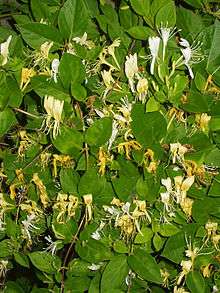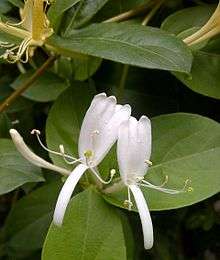Lonicera japonica
| Japanese honeysuckle | |
|---|---|
 | |
| Scientific classification | |
| Kingdom: | Plantae |
| (unranked): | Angiosperms |
| (unranked): | Eudicots |
| (unranked): | Asterids |
| Order: | Dipsacales |
| Family: | Caprifoliaceae |
| Genus: | Lonicera |
| Species: | L. japonica |
| Binomial name | |
| Lonicera japonica Thunb. | |
| Synonyms[1] | |
| |
Lonicera japonica, the Japanese honeysuckle[2] or suikazura (スイカズラ/吸い葛 in Japanese; jinyinhua in Chinese; 忍冬 in Chinese and Japanese) is a species of honeysuckle native to eastern Asia including China, Japan and Korea. It is a twining vine able to climb up to 10 metres (33 ft) high or more in trees, with opposite, simple oval leaves 3–8 centimetres (1.2–3.1 in) long and 2–3 centimetres (0.79–1.18 in) broad. The flowers are double-tongued, opening white and fading to yellow, and sweetly vanilla scented. The fruit is a black spherical berry 3–4 millimetres (0.12–0.16 in) diameter containing a few seeds.[3]
It is an invasive species in a number of countries.
Cultivation and uses
This species is often sold by American nurseries as the cultivar 'Hall's Prolific' (Lonicera japonica var. halliana). It is an effective groundcover, and has pleasant, strong-smelling flowers. It can be cultivated by seed, cuttings, or layering. In addition, it will spread itself via shoots if given enough space to grow.
In both its native and introduced range, Japanese honeysuckle can be a significant source of food for deer, rabbits, hummingbirds and other wildlife.[4]
The variety L. japonica var. repens[5] has gained the Royal Horticultural Society's Award of Garden Merit.
Invasive species

Japanese honeysuckle has become naturalized in Argentina, Australia, Brazil, Mexico, New Zealand and much of the US, including Hawaii, as well as a number of Pacific and Caribbean islands.
Japanese honeysuckle is classified as a noxious weed in Texas,[6] Illinois, and Virginia, and is banned in New Hampshire.[7] It grows extremely rapidly in parts of America such as southwestern Ohio and is virtually impossible to control in naturalized woodland edge zones due to its rapid spread via tiny fruit seeds. It forms a tall dense woody shrub layer that aggressively displaces native plants. It is also very difficult to manage in semi-wild areas, such as in large rural yards.
It is listed on the New Zealand National Pest Plant Accord as an unwanted organism.[8]
It can be controlled to some degree via labor-intensive methods such as cutting or burning the plant to root level and repeating at two-week intervals until nutrient reserves in the roots are depleted. It can also be controlled through annual applications of glyphosate, or through grubbing if high labor and soil destruction are not of concern. Cutting the honeysuckle to within 5–10 cm of the ground and then applying glyphosate has proven to be more effective, provided that the mixture is rather concentrated (20–25%) and is applied immediately after making the cut.
Chemistry
Lonicera japonica contains methyl caffeate, 3,4-di-O-caffeoylquinic acid, methyl 3,4-di-O-caffeoylquinate, protocatechuic acid, methyl chlorogenic acid and luteolin. These compounds have an inhibitory effect on human platelet aggregation that may explain the possible role of Japanese honeysuckle in maintaining vascular homeostasis.[9][10] The two biflavonoids, 3′-O-methyl loniflavone and loniflavone along with luteolin and chrysin can be isolated from the leaves.[11] Other phenolic compounds present in the plant are hyperoside, chlorogenic acid and caffeic acid.[12]
The two secoiridoid glycosides, loniceracetalides A and B, can be isolated, together with 10 known iridoid glycosides, from the flower buds.[13]
The plant also contains the saponins loniceroside A and B[14] and the antiinflammatory loniceroside C.[15]
Traditional Chinese medicine
In traditional Chinese medicine,[16] Lonicera japonica is called rěn dōng téng (Chinese: 忍冬藤;[16] literally "winter enduring vine" ) or jīn yín huā[16] (Chinese: 金銀花; literally "gold silver flower"). Alternative Chinese names include er hua and shuang hua.[17] In Korean, it is called geumeunhwa. The dried leaves and flowers (Flos Lonicerae Japonicae) are employed in traditional Chinese medicine, being used to treat fever, headache, cough, thirst and sore throat.[18]
In 2014, Chinese researchers led by Dr Chen-Yu Zhang of Nanjing University reported that "MIR2911, a honeysuckle (HS)-encoded atypical microRNA, directly targets IAVs with a broad spectrum."[19]
References
- ↑ "The Plant List: A Working List of All Plant Species". Retrieved 7 December 2014.
- ↑ "BSBI List 2007". Botanical Society of Britain and Ireland. Archived from the original (xls) on 2015-02-25. Retrieved 2014-10-17.
- ↑ Flora of Taiwan: Lonicera japonica
- ↑ Forest Plants of the Southeast and Their Wildlife Uses, James H. Miller and Karl V. Miller, University of Georgia Press, Revised Ed. 2005, p.278
- ↑ "RHS Plant Selector - Lonicera japonica var. repens". Retrieved 22 May 2013.
- ↑ "Lonicera japonicaJapanese honeysuckle".
- ↑ http://gencourt.state.nh.us/rules/agr3800.html
- ↑ Biosecurity New Zealand - Japanese honeysuckle
- ↑ Inhibition of platelet activation and endothelial cell injury by polyphenolic compounds isolated from Lonicera japonica Thunb. W.-C. Chang and F.-L. Hsu, Prostaglandins, Leukotrienes and Essential Fatty Acids, Volume 45, Issue 4, April 1992, Pages 307–312, doi:10.1016/0952-3278(92)90088-Z
- ↑ Constituents from Lonicera japonica. Li-Yan Peng, Shuang-Xi Mei, Bei Jiang, Hong Zhou, Han-Dong Sun, Fitoterapia, Volume 71, Issue 6, December 2000, Pages 713–715, doi:10.1016/S0367-326X(00)00212-4
- ↑ Biflavonoids from Lonicera japonica. Neeraj Kumar, Bikram Singh, Pamita Bhandari, Ajai P. Gupta, Sanjay K. Uniyal and Vijay K. Kaul, Phytochemistry, December 2005, Volume 66, Issue 23, Pages 2740–2744, doi:10.1016/j.phytochem.2005.10.002
- ↑ Determination of Phenolic Acids and Flavones in Lonicera japonica Thumb. by Capillary Electrophoresis with Electrochemical Detection. Youyuan Peng, Fanghua Liu and Jiannong Ye, Electroanalysis, March 2005, Volume 17, Issue 4, pages 356–362, doi:10.1002/elan.200403102
- ↑ Secoiridoid glycosides from the flower buds of Lonicera japonica. Rie Kakuda, Mio Imai, Yasunori Yaoita, Koichi Machida and Masao Kikuchi, Phytochemistry, December 2000, Volume 55, Issue 8, Pages 879–881, doi:10.1016/S0031-9422(00)00279-X
- ↑ Triterpenoid saponins from the aerial parts of Lonicera japonica. Kun Ho Son, Keun Young Jung, Hyeun Wook Chang, Hyun Pyo Kim and Sam Sik Kang, Phytochemistry, March 1994, Volume 35, Issue 4, Pages 1005–1008, doi:10.1016/S0031-9422(00)90656-3
- ↑ Loniceroside C, an Antiinflammatory Saponin from Lonicera japonica. Wie Jong Kwak, Chang Kyun Han, Hyeun Wook Chang, Hyun Pyo Kim, Sam Sik Kang and Kun Ho Son, Chem. Pharm. Bull., 2003, volume 51, issue 3, pages 333—335 (article)
- 1 2 3 Shang, X.; Pan, H.; Li, M.; Miao, X.; Ding, H. (2011). "Lonicera japonica Thunb.: Ethnopharmacology, phytochemistry and pharmacology of an important traditional Chinese medicine". Journal of Ethnopharmacology 138 (1): 1–21. doi:10.1016/j.jep.2011.08.016.
- ↑ Chinese Medical Herbology and Pharmacology, John and Tina Chen, Art of Medicine Press, 1st ed. 2001, p. 171
- ↑ Bensky, Dan; Barolet, Randall. Chinese Herbal Medicine Formulas & Strategies (2nd ed.). Eastland Press. p. 44.
- ↑ Zhen Zhou; Xihan Li; Jinxiong Liu; Lei Dong; et al. (7 October 2014), "Honeysuckle-encoded atypical microRNA2911 directly targets influenza A viruses", Cell Research advance online publication, doi:10.1038/cr.2014.130
External links
| Wikimedia Commons has media related to Lonicera japonica. |
- Plants For A Future: Lonicera japonica
- Species Profile- Japanese Honeysuckle (Lonicera japonica), National Invasive Species Information Center, United States National Agricultural Library. Lists general information and resources for Japanese Honeysuckle.